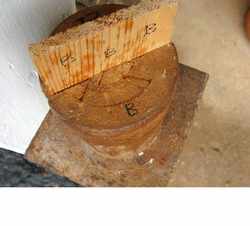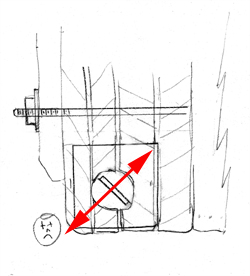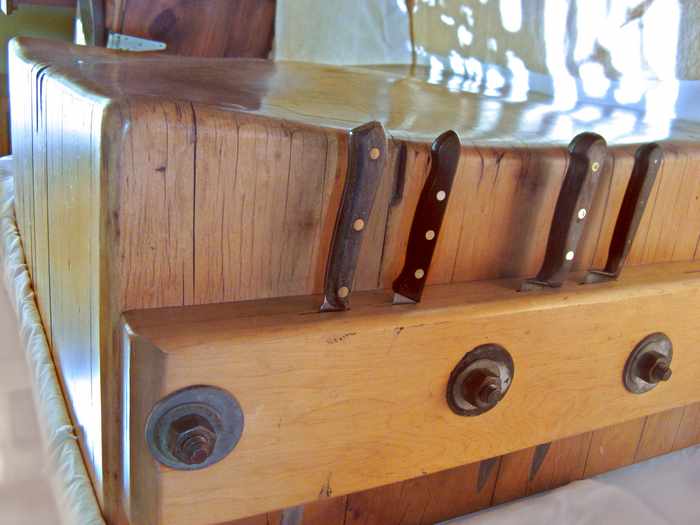"Tina's
Tiny Table Top"
A Butcher Block from the
Ridgway Refrigerator Company,
Philadelphia ca. 1900
--=o=--
J. I. Nelson, Ph.D. 2009
bottom & links
In
1970 I stumbled across an abandoned butcher block lying on its
side in a tumble-down shed. Now,
40
years later, I need a household without 400 lb pieces of furniture --
and a new friend for my butcher block. This is the story of
the
butcher block's passage through its life, and through mine,
to a new
home.
Part I; The Butcher Block's Life - YOU ARE HERE
Part II. The Butcher Block and Me
SIZE & WEIGHT
31"
x 35" x 33" high,
400 lbs
The
block itself is 31" square.
The
2" thick knife holders on either side bring the block's
dimensions to 31" x 35".
The
bolts are longer still:, so overall
clearance is 31" x 37"
The
maple block is about 15 1/2" high (originally
thickness16"?)
Legs
are 17 1/2" long, 20 1/2" overall.
15.5
+ 17.5 = 33" high.
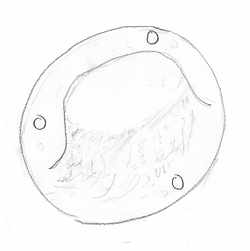 BOLTS:
The original block had
four 5/8" through-rods, threaded 5/8-11
(NC,
standard National Coarse threading). Adding the knife holders required
new, longer rods (again, 5/8-11). All butcher blocks
this size
that I have seen have through-rods, but on some blocks, nut and washer
are in a recessed hole, and the hole is covered with a wooden
plug. This block originally had cup-shaped metal bolt covers
over
the nuts.
BOLTS:
The original block had
four 5/8" through-rods, threaded 5/8-11
(NC,
standard National Coarse threading). Adding the knife holders required
new, longer rods (again, 5/8-11). All butcher blocks
this size
that I have seen have through-rods, but on some blocks, nut and washer
are in a recessed hole, and the hole is covered with a wooden
plug. This block originally had cup-shaped metal bolt covers
over
the nuts.
Weight
385 lbs top + 15 lbs legs = 400 lbs.
BOARDS &
BUTCHER BLOCKS
98
pieces of 7/4 maple board make up the butcher block.
The
boards of "7/4 maple" stock were all cut to 16" lengths.
The boards' widths vary, down to square (1 3/4" x 1 3/4").
The
boards are stacked ends-up to form a true butcher block surface of
end-grain wood. Maple is a diffuse-porous wood like cherry
and
can be used this way. Ring-porous woods like oak -- the ones
with obvious, regular tree rings -- would split.
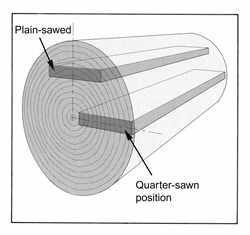 Long
7/4 boards (12 feet, not 16 inches) from this era were used to make
maple counter tops. Older counters have boards as wide as 12
inches. Gluing (joining) boards edge-to-edge to reach the desired
counter top width is sometimes called "jointed
flat-grain construction".
The counter top exposes boards of varying widths, some
well-figured -- with a nice "grain" pattern, people say. But
"grain" is the wood's small fibers ("That water raised the grain -- the
board feels fuzzy." "The plane caught, it lifted the grain and made a
small pock mark."). Pretty patterns that tree rings trace across
a board's surface are the wood's "figure."
Long
7/4 boards (12 feet, not 16 inches) from this era were used to make
maple counter tops. Older counters have boards as wide as 12
inches. Gluing (joining) boards edge-to-edge to reach the desired
counter top width is sometimes called "jointed
flat-grain construction".
The counter top exposes boards of varying widths, some
well-figured -- with a nice "grain" pattern, people say. But
"grain" is the wood's small fibers ("That water raised the grain -- the
board feels fuzzy." "The plane caught, it lifted the grain and made a
small pock mark."). Pretty patterns that tree rings trace across
a board's surface are the wood's "figure."
From a
woodworker or sawmill's point of view, 12" wide maple boards
can
only be obtained by "plainsawing" across the entire tree. Boards which
are narrower and which do not pass through the center of the tree are
all called "plainsawed". Particularly for
ring-porous woods like oak, the figuring of plain-sawed boards is
stronger, as the plane of the board intersects the rings of the tree,
making conic sections and other patterns. Although
plain-sawed
boards are the plentiful, cheap ones, plain-sawed boards need
more careful drying and aging, as they are most likely to
warp.
Most
shrinkage in wood occurs along the annual rings, and these are not
aligned with either the wide surface or the narrow edge of a
plain-sawed board .
. . and, they may slant in opposite directions on opposite
edges of the board, because the tree was small. This produces
cupping when everything is symmetrical, and horrible curvature or even twist when
it isn't.
Even
today, 1
3/4" remains a standard maple counter top thickness.
Counters
thicker than 7/4 are made by turning boards on 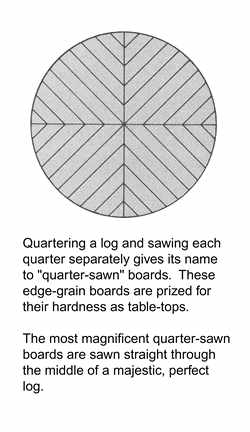 edge
and gluing the plain-sawed faces. For a 2 1/4" thick
industrial
counter top, for example, all the 7/4 maple boards are ripped
and jointed to that 2
1/4" width, then glued. The counter top with this "edge-grain
construction"
exposes homogeneous-width strips with little or
no
figure, but greater surface hardness.
edge
and gluing the plain-sawed faces. For a 2 1/4" thick
industrial
counter top, for example, all the 7/4 maple boards are ripped
and jointed to that 2
1/4" width, then glued. The counter top with this "edge-grain
construction"
exposes homogeneous-width strips with little or
no
figure, but greater surface hardness.
Edge-grain
construction is a compromise between end-grain construction
(the
hardest) and jointed flat-grain construction (the softest but sometimes
best-patterned). Only end-grain construction should be called
a
"butcher-block counter top" -- "edge-grain
construction" is an also-ran, and "jointed
flat-grain construction" has nothing to do with what you see in any real butcher block.
The
most sought-after
boards from any tree:
Return to that one plain-sawed cut through the center of the tree.
Except for the very middle, most of that board is edge-grain;
most of it is a stack of perfect annual rings. Cutting this
down
the center to get rid of problems (sap pockets, rot), the two
boards from the left and from the right side of the tree are
called "quarter-sawn". Normally logs are quartered to make
quarter-saw boards -- see illustration.
Quarter-sawn
lumber is the most
treasured
for table tops, whether the finest dining room furniture or workshop
counters, whether hard or softwood. It combines the hardness
of
edge grain with the beauty of boards having--like plain-sawn boards--
greater, varying width and more aesthetic figure. The boards
are normally not very wide. In the
rare,
perfect tree, "cheap" plain-sawing yields a magnificent, wide,
edge-grain
board from the log's one center-cut only. People paw through the stock at lumber mills hoping to find one.
Edge-grain
counter top construction is not only a compromise in
hardness between the jointed flat-grain (plain-saw) approach and
end-grain, it is also what you do in a world without thick, premium
quarter-sawn boards because that world has lost its
large-caliber, first-growth, native
hardwood trees.
THE RIDGWAY
REFRIGERATOR COMPANY
The
butcher block had
a stamp burned into its side and nearly obliterated by weathering.
There was nothing to photograph. I figured out what it said
and
sketched the stamp in my pocket reminder book for that day in July,
1970: As we shall see, this stamp fixes 1907 as the block's
oldest possible
date
of birth.
The
Ridgway Refrigerator was active in the 1890s.
The
text above reads:
The
Ridgway Refrigerator
Manufacturing Co. Ltd.
formerly The Ridgway Patent Refrigerator Company Limited
815 Arch St.
Stock issue expires 28 July 1902.
Capital, cash, $30,000.
Shares 60, par $500.
Manufacture and sale of refrigerators.
Officers: R. Biddle, Jr., Chairman
Wallis Boileau, Secretary
B. Hallowell, Jr., Treasurer
Besides
this entry in a leather-bound listing of "Philadelphia
Securities
1892", the company appears in a 1907-1909 company listing has having
shortened its name ("charter") to "Ridgway Refrigerator Company," the
name stamped on this butcher block. This fixes the oldest
possible date of the block at 1907.
The
oldest
date I find for the company itself is 1886, the year two
men
-- presumably employees -- assigned their patent rights to
the
company. The Annual Report of the Commissioner of Patents by
the United States Patent Office for 1886 reports that William J.
Taylor and H. J. Chester are assignors of their
patent
rights to the Ridgway Refrigerator Manufacturing Company Ltd.
LUMBER BARONS and MILLIONAIRES
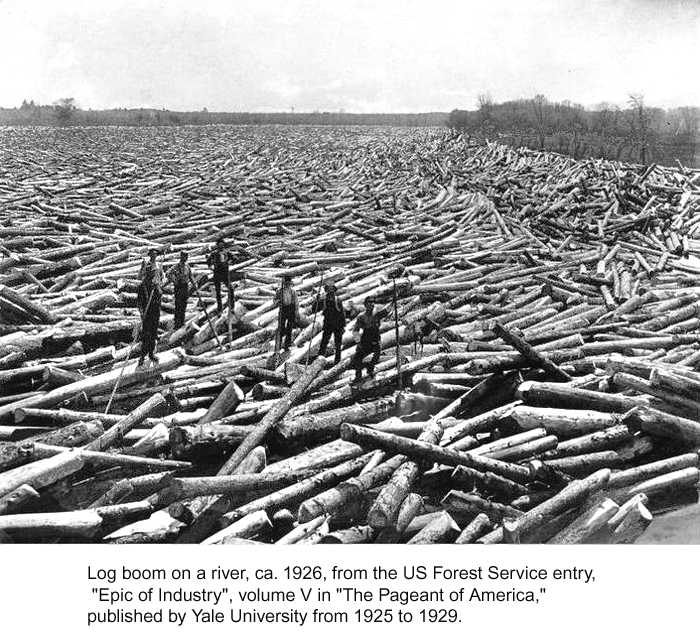
During
the lumbering frenzy of the late 1800s, the log boom across the Susquehanna at
Williamsport held back the world's largest log pile. The boom
itself was made of logs chained together. If your logging
venture
was participating in that season's "river drive," you would
clear-cut the hills to which you could claim rights ("claim" is the
polite word), brand the logs like heads of cattle,
and drive
them through the Susquehanna Boom for a tariff . Your brand
of
logs had to be sorted into their own circular boom and taken down to
the holding pond of the mill you used for sawing (the "mill
pond"). Every step made (extracted) money, and people who
fought
their way towards a vertical monopoly made the most. The
1880s
were the opposite of the 1980s, when many industries
globalized
and "delaminated"; i.e. businesses became more specialized
and mutually cooperative, supported by computerized
business practices and a global, data-oriented networks for
connecting them.
As
America first industrialized, whoever
owned the Susquehanna Boom could charge levies on every log
that passed it. At the height of the lumber
industry in Lycoming County, 1861-1891, the mills produced
5.5
billion board feet of lumber. Williamsport became one of the most
prosperous cities in the United States, with more
millionaires
per capita than any other town. Men like James H.
Perkins,
Peter
Herdic, and Mahlon
Fisher became millionaires while many of the men who actually worked in
the river struggled to survive on the wages paid them by the lumber
barons. Some died of injuries. Williamsport is
worth
visiting today just to see the architectural landmarks left in the town
by Peter Herdic. To retain control of the Susquehanna Boom,
the
richest tollgate on land or water, Herdic proceeded to
bribe every
legislator in the state assembly.
In big
cities like Philadelphia, the flood of native hardwoods
created companies like the Ridgway
Refrigerator and Manufacturing Company and products like this butcher
block.
(Further north, oak fed office and home furniture
industries.)
In the
1860s the state of Pennsylvania led the nation in lumber
production. By 1900, the state it had dropped to fourth
place. Clear-cutting insured that hillsides would not come
back. Most
hardwood produced today is low-grade from small-diameter trees and
winds up as a shipping pallet.
The
plundering of virgin native-growth (first-growth) forests by members of
his
own family disturbed James Pinchot, who left Milford, PA, to return a
millionaire from his success as a wallpaper dealer in New York City.
He endowed the Yale
School of Forestry
in 1900 -- the first graduate forestry program in the country -- too
late for his son Gifford Pinchot (Yale, '89). From Grey Towers,
the family estate in Milford overlooking the Delaware
River, James
sent Gifford to a postgraduate year at the French National
Forestry School. As the nation's first professional forester, James'
son would make amends.
When Federal
supervision of the nation's forests was transferred to the Department
of Agriculture in 1905, Gifford Pinchot (1865-1946) was put
in
charge. He served from 1905-1910 and later won two
terms as
governor of the
state of Pennsylvania. That "Bureau of Forestry"
became the
US
Forest Service.
PROTECTING OURSELVES FROM
THE PROTECTORS
John
Muir
(1838 – 24 December 1914) joined forces with Gifford Pinchot long
enough (1896-1897) to launch the nation's conservation movement.
 Pinchot
was a utilitarian untouched by Muir's respect for the spiritual value
of beauty.. For Pinchot, the world was new, and Man
would
control it. Man controlled nature; and nature would support
man
as he spread and multiplied. For Pinchot, forests were tree
farms
-- cut one down, plant another. If planted trees made softer
wood, that was an engineering problem. If native growth trees
made boards with swirling figures, that only made them harder to mill
into furniture. If swirling figures looked different from
plain
grain, that was only beauty and of no intrinsic value to Man's
Progress. Theodore Roosevelt came to Gifford
Pinchot's wedding. His wife
added
an outside dining room to their mansion so that more guests could be
entertained as the couple sought the Senate, the House and the state
governorship. Buoyant bowls floated the food from guest to guest at
"The Finger Bowl" table (photo, right). The family
mansion is open to
the public today.
Pinchot
was a utilitarian untouched by Muir's respect for the spiritual value
of beauty.. For Pinchot, the world was new, and Man
would
control it. Man controlled nature; and nature would support
man
as he spread and multiplied. For Pinchot, forests were tree
farms
-- cut one down, plant another. If planted trees made softer
wood, that was an engineering problem. If native growth trees
made boards with swirling figures, that only made them harder to mill
into furniture. If swirling figures looked different from
plain
grain, that was only beauty and of no intrinsic value to Man's
Progress. Theodore Roosevelt came to Gifford
Pinchot's wedding. His wife
added
an outside dining room to their mansion so that more guests could be
entertained as the couple sought the Senate, the House and the state
governorship. Buoyant bowls floated the food from guest to guest at
"The Finger Bowl" table (photo, right). The family
mansion is open to
the public today.
For Pinchot's US Forest Service, "conserve"
meant exploiting resources in (hopefully) renewable ways.
What happened? In the Dept. of Agriculture, farmers produce
soybeans, corn, wheat, with subsidies
Congress cannot stop.
Cattlemen have access to public grazing lands; and
lumbermen have access to forests.
The
butcher block gave us the US Forest Service, but only
through
John Muir did we get protection from the protectors.
As
co-founder and first president of the Sierra Club, Muir wielded
national power and walked with Presidents. His friendship
with
Gifford Pinchot ended in 1897 over a sheep grazing dispute,
and
sharpened with the campaign to dam Hetch Hetchy Valley,
which violated Yosemite National Park, CA. The ultimate
approval
of the dam was heartbreaking to Muir, who died a year after losing
this, his
last great fight. A national park had been exploited, an
entire valley destroyed
State power? The
violation of a national park to build a dam led ultimately to
the
formation of the National Park Service (1917) to protect all
national parks. Stephen
Tyng Mather
(July 4, 1867 - January 22, 1930) was first director (1917)
of the helpless,
new National Park Service in the Dept of the Interior (the
Forest Service remains in the Dept. of Agriculture).
A
millionaire (Thorkildsen-Mather Borax Company),
manic-depressive, and tireless promoter of rail and road access to the
parks, Mather understood that the parks' product was beauty, not lumber
or dammed water. The Parks became overrun with tourists
arriving
on Mather's roads, but that success brought political power, and the goal of
cherishing beauty was established.
Robert Underwood Johnson,
editor of Century
Magazine
which published many of John Muir's articles, wrote that "the world
will ... remember the voice of one crying in the
wilderness and bless the name of John Muir. . . . He sung the glory of
nature like another Psalmist, and, as a true artist, was unashamed of
his emotions. ... His countrymen owe him gratitude as the
pioneer of our system of national parks. . . . Muir’s writings and
enthusiasm were the chief forces that inspired the movement. All the
other torches were lighted from his."
The
plunder and pillage of the Eastern hardwood forests got us this butcher
block and at least some
professional forest management, but it took the stunning beauty of the
West to get us a Park Service for preserving our best
lands, not just conserving
their resources by exploiting them in what we are told are renewable
ways. ad
CUSTODIANSHIP
This
country will never again stack 400 lbs of rock
maple together to sell butcher blocks to the
world --
never mind that industrialized pork production caused this
butcher
block to be abandoned, and caused the market for all of them to disappear -- to disappear from family
corn-and-hog
farms, from neighborhood butcher shops (see,
for
example, the documentary film Food,
Inc,
available from amazon).
This
butcher block was older than I was when I got it, and it still
is.
Now I must pass it on. I have lavished an
irrational
amount of
care on it, despite international moves to Europe and Australia.
I wanted this butcher block to be there when I wasn't.
So
if doing something that does not benefit you, and you first, is
irrational, then I stand guilty as accused. I hope it stays
with
the next owner
for generations.
HAIL, SALE AND FAREWELL: We
got a quick answer to our classified ad. The First Responders
didn't seem to think me crazy to ask if the block would have a good
home. There were several
romantic
window shoppers with no idea of what shipping a 400 lb object entailed,
let alone just lifting it.
"This
weighs 400 lbs.
Are you sure you can handle it?" I asked one First
Responder, a
Little Girl Voice (Tina) on the other end of a long-distance call.
"We
run a family business, Atlantic
Structure Movers.
We move
houses."
I
put down the phone.
Most
people walk away, tear down, build new. A
structure-moving company caters to people who have something of
historic value, who respect the cultural significance of
things,
who understand that continuity of place supports a family across
generations. That is the connection. My butcher
block will
have a good home. I hope they keep it forever.
Part I; The Butcher Block's Life
Part II. The Butcher Block and Me - YOU ARE HERE
ACQUISITION, 1970
We
conclude with the butcher block's acquisition, and its care and
assembly, ending with contact information for the
previous
(original?) owners in
Delaware.
I
got this butcher
block on the Fischer family farm in Lewes, Delaware, in the
summer
1970. Robin and I (Swarthmore College 1967 and 1965
respectively)
were visiting schoolmate Donna Fischer and her first husband Carl F
Goodwin (both Swarthmore class of 1968) on her parents' farm.
Donna
said Let's pile into the car and cruise the dairy queen as she did in
high school. I thought, This is one of those mythical family
farms and I want to see it, so after ice cream all around, we set out
walking across a vast cornfield with a shed at the distant edge.
The cornfield's rows went around the shed -- no yard, no path,
no
visitors, the most totally ignored structure ever built.
The butcher block was lying alone inside. The
shed
had been a slaughter house for the farm. Years later in the midst of restoring it, I
would
find blood between the butchering block's boards. Being on its
side,
all four leg bottoms were dry and perfect. The butcher block
wasn't in the mud exactly, but on soggy floorboards. Perhaps
the
shed's flooring had collapsed and that's how the block tipped over in
the first place. Slow, silent death, unable to crawl to the
phone for help.
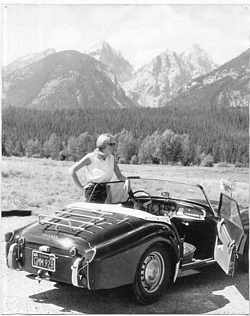 I
had to have it. I begged. Donna Fischer asked her
parents if it was OK. They said they weren't raising
hogs
anymore, so if you can figure out how to move it, it's yours.
I
had courted Robin with a real sports car, but now I had a VW bug to
prove I was not only married, but sensible. We borrowed tools
and
unbolted the front seat entirely. My new passenger took up
the
entire passenger side of the car. I didn't want to leave
either
the butcher block or the car seat behind, plus I had a wife.
Robin rode home to Long Island in the back of a VW beetle, with the seat on her lap,
begging
to be let out. The VW bug listed badly to the side.
I could
turn right
at any speed, like being back in my sports car again, but on long
interstate ramps to the left I wondered if we'd hear the running board
scraping on the concrete roadway before the whole package just rolled
down the embankment. We stored the butcher block in a
friend's
basement while I finished my Ph.D. on Long Island and did postdocs in
Chicago and then Australia. The Fulbright to Australia spun
out
into 5 years. On trips home, I went down into the
basement, opened the can of linseed oil, and gave the butcher block
another coat to preserve the wood.
I
had to have it. I begged. Donna Fischer asked her
parents if it was OK. They said they weren't raising
hogs
anymore, so if you can figure out how to move it, it's yours.
I
had courted Robin with a real sports car, but now I had a VW bug to
prove I was not only married, but sensible. We borrowed tools
and
unbolted the front seat entirely. My new passenger took up
the
entire passenger side of the car. I didn't want to leave
either
the butcher block or the car seat behind, plus I had a wife.
Robin rode home to Long Island in the back of a VW beetle, with the seat on her lap,
begging
to be let out. The VW bug listed badly to the side.
I could
turn right
at any speed, like being back in my sports car again, but on long
interstate ramps to the left I wondered if we'd hear the running board
scraping on the concrete roadway before the whole package just rolled
down the embankment. We stored the butcher block in a
friend's
basement while I finished my Ph.D. on Long Island and did postdocs in
Chicago and then Australia. The Fulbright to Australia spun
out
into 5 years. On trips home, I went down into the
basement, opened the can of linseed oil, and gave the butcher block
another coat to preserve the wood.
We
returned from Australia in 1978 to a job at the State
University of New
York at Stony Brook, Dept. of Neurobiology, and retrieved the
butcher block.
There had been particulate matter in the basement (smoky
furnace?). The linseed oil had remained
receptive a
long time because there was little air movement and no ultraviolet
radiation from the sun to dry it. Instead of the rich, deep
wood
color I imagined after 8 years of TLC, the block was, in
fact,
almost black and would have to be refinished. After work on
the
house itself, I turned to the butcher block in early 1980. My
son
was at the age when everything is fascinating and Daddy seems normal.
RESTORATION, 1980
1.
Down to the wood.
There
was no finish to save. I went down to the wood with
hand planes on
all four sides, removing the discoloration (photo above; the
author and
Lorrin, April, 1980).
2.
Soft on one side.
One
side
(one with bolt heads) had been the side on the
ground
(on the
old shed's disintegrating floor boards). The wood is still
stained with iron today (blueish black) from the bolt covers which
rusted through (sketch, right; stains below, running out from under the new bracing boards). I abandoned
the idea of bolt
covers because I wanted to use washes as large as the bolt covers
themselves. Then I would be able to apply
tremendous
pressure to stabilize the block once I got the alignment right.
3.
Knife holder "bookends" with new bolts.
Even
with large washers, the softened wood in the
first layer of boards on one side might get crushed. I had
seen
butcher blocks
--
mostly smaller ones intended for use in retail butcher shops -- that
had knife holders on opposite ends, so I added rock maple knife holders
to use as "clamp faces" under the bolts. This
brought to
wood to 31"
+
(2 x 2")) = 35", so all the pre-threaded, 36" long rods in all the
hardware stores of America were useless. I needed
37".
I know this never happens to you, but in my life there are always
projects like this. I
ordered 5/8 plain rod from a steel dealer, cut generous 37" lengths,
and threaded all the ends with the same 5/8-11NC thread -- better than
the hardware store, black rods with threading just at the ends, just
like before. Just do a couple rods, wait for your hands to
heal,
do some more. I had had a college-level course in machine
shop
practice, but my basement was no machine shop.
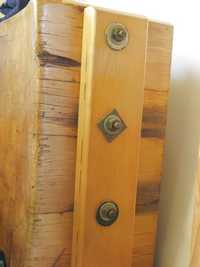 4. Sand
top, apply finish.
4. Sand
top, apply finish.
I
was able to scrape and sand the top without losing the contour because
the dirty linseed oil was soft and the endgrain was hard. I
sanded until there was no scratch anywhere from sandpaper, and the old
cleaver marks from slicing and slaughtering emerged. The rounding
of every edge began to look optically perfect in reflected light. The
refinishing itself --
however regrettable -- became invisible.
Since
I wasn't
going to use the block for cutting wet food, I gave the top and the
sides the same coat of varnish. The top got almost nothing --
rubbed on with a rag, not painted with a brush. The top had
been
virtually pre-polished by a progression of finer grits to a
shiny
surface even unfinished -- it didn't need much.
To use the block for food, rub the surface with tung oil or Behlen
salad bowl finish in order
to add a coat with some
penetration.
5.
Be the first in 100 years to re-glue.
To
this day, the block falls apart into a dozen and a half big hunks and
several smaller pieces. It is not [re-]glued. The
breaks are mostly along the old glue
lines, which have failed
from age and dampness in the slaughter shed, but some splits are right
through the boards.
click
either image to enlarge
Men worked at each corner, leaving the worn surface saddle-shaped (left).
Nails hammered into the block to hold a rag made the chips at the edge.
The surface still shows the marks of old cleaver blows (right).
STEWING OVER
GLUING
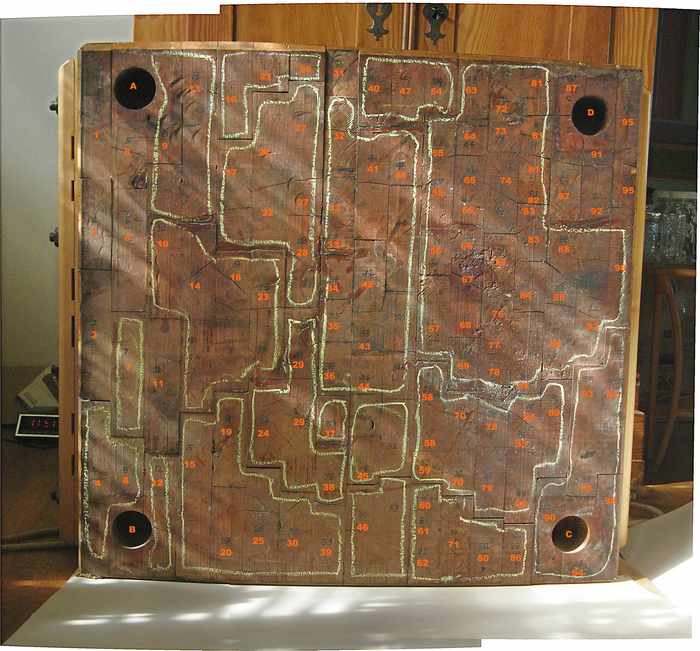 click to enlarge
click to enlarge
Chalk
lines trace the
chunks into which the butcher block falls apart.
One or two breaks cross a (broken) board.
The pencil numbers on the 98 boards that make the block are repeated in
red on the photo.
The legs are keyed A-B-C-D going counterclockwise.
Hammer marks on the bottom commemorate my efforts to get the top even.
 GLUING
GLUING:
I was chicken to glue the block back together. My
excuse
was that I might move, and yes, the whole thing did go to
Germany with
us, but we traveled with His and Hers SeaLand containers and didn't
need to take any furniture apart. The real reason for not
re-gluing was that I
didn't know if I'd ever get the top perfect. I might have to
accept a
corner on an individual piece (or two) that was not lining up because
it had become misaligned during use and that corner got rounded
off. But I got the top perfect. Now that we know all pieces
can slide into
alignment -- I say, Glue it.
Use only animal or "liquid hide glue," as a curator or
restorer of any piece of antique furniture would also do.
- Modern glues are stronger than the wood -- breakage is
guaranteed to destroy the object, not open a joint.
- Liquid
hide glue takes a long time to set, and you may need hours before you
can run your fingers (crossed!) across the top, know it is perfect, and
tighten those bolts.
- Liquid hide glue is slippery & gelatinous, while many modern glues are thixotropic (designed to be
sticky).
You need to slide the pieces.
EXPANSION/CONTRACTION
AS THE SEASONS ROLL: :
The wood "works". Even with air conditioning, the
block
expands in summer and contracts during the dry winter heating season.
If you don't tighten the bolts as winter sets in,
you may lose it.
If you forget to loosen a sixth-turn (15 mills) every once in
a
while in summer, the washers will crush their way into the knife
holders as the massive wood object expands. When
that happens, the
block
has changed shape -- permanently. During the next winter
contraction, it will be looser. If the block were glued, the
bolts wouldn't have to be tight enough to cause a "summer expansion
crush". Everything's OK so far, but
glued would be simpler in the end.

click to enlarge
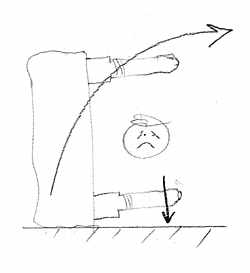 PUTTING
THE LEGS ON
PUTTING
THE LEGS ON
If
you just put the legs on and expect to tilt the block back up, then you
need guys prepared to lift 400 lbs of dead weight. And there
is
no hand purchase. This means your guys should
have canvas belts
(like piano movers) and know how to use them.

I
made a support that went under the knife holders, and had my helpers in
Germany put the block up on the supports. I raised the block
3
more inches with two
pairs of wedges to get the legs into their holes, then lowered the
block
to drive the legs in. After adjusting the legs' fox tail
wedges
for a tight fit for each leg (see below), I took the supports away.
You could bring this technology from the age of the Pharaohs
to
the Industrial Age by creating a support with enough free space for a
couple hydraulic (car) jacks -- see diagram.
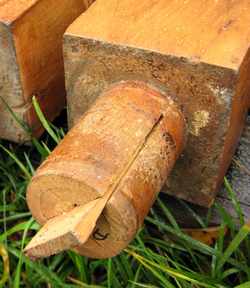
4x4
stock is turned down to a 2" diameter "dowel" to fix each leg
in
place. The
3" long
dowels slides into 4" long holes. As they hit the hole's
bottom,
foxtail wedges are forced into the dowel, locking the leg tight.
The length dimensions are very critical. The legs
are keyed
to their holes and the wedges can't trade legs. Twist each leg in
and out of its hole and learn to feel where the foxtail wedge hits
bottom. A wooden carpenter's clamp (wooden handscrew clamp) makes
a good wrench to turn a leg that sticks. You shouldn't
be
satisfied with anything less than a perfectly tight leg -- no wobble --
so put half a 3x5 file card folded into the bottom of the hole to push
harder on the wedge and lock the leg a little tighter when you are done
and drive all the legs home later. Move up
gradually. If you overdo it,
the leg
will lock before it is seated and you may not be able to get it out.
Rub the dowels down with an old candle if you can't find
beeswax.
Believe me, making a 2" diameter dowel slippery so you can
position it is not a problem. It will lock up solid as steel
when you get the wedge (& file-card filler) right.
The
foxtail wedge runs obliquely inside the leg, corner to corner.
With the tops of the legs aligned with the corner of the butcher
block itself, we find a bad and a good orientation for the wedge.
The bad
orientation splits the corner out of the block; the good orientation
puts pressure against the tensile strength of the steel bolt
on
one side, and against a long stack of boards on the other side.

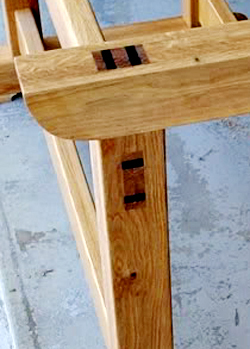
Blind (left) and exposed or "through" (
right)
foxtail-wedged mortise
& tenon joints.
The
foxtail wedged joint is traditional in furniture joinery. A
century ago, it was often "blind" (hidden) as the leg joints of the
butcher
block are. In modern times, through-joints are more
common; the
fox-tailed mortise and tenon joint is considered decorative.
(In a mortise and tenon joint, the tenon is the "tongue" that
sticks into or through the other piece being joined.)
THE OWNERS BEFORE
1970
The
block was on the family farm of Donna Elaine Fischer (Swarthmore
College, Class of 1968)
Alumni
Office address in 2009:
10
Lighthouse Way
Lewes, Delaware 19958
tel (302) 645-7922
Signed
up for 40th reunion in 2008.
Sometimes
goes by Donna Fischer-Scrivo, taking the name of her 2nd
husband.
The
Fishers,
a Quaker family, have lived in Lewes at
least since the Revolutionary War.
If we can get in touch with Donna, we could learn if she is part of
that family but uses a variant on the spelling of "Fisher", or
whether the names are just a coincidence. All of us (Donna
and her first husband, Robin & I) certainly
met
at a Quaker-founded institution, Swarthmore College. In any
event, the length of time her family owned the farm property would be
helpful for dating this butcher block. The date her
father or
grandfather launched into corn and hog farming points to
the date a butcher block became needed and might have been
acquired. As noted above, this butcher block
is not older than 1907,
based
on the variant of the company name once stamped on it.
--end
FAN LETTER (thank you!)
Date: Mon, 4 Apr 2011
Subject: RE: butcher block story
From: LM
To: jerry-va@speakeasy.net
RE: http://www.nerdylorrin.net/jerry/r+j/MyButcherBlk/ButcherBlk.html
I just had to thank you for your wonderful write up on your old butcher
block. I fell in love with one myself, back in my early 20's, and
saved it from an old home in Corktown outside of downtown
Detroit. I'm still amazed that I managed to get it out of the
1800's house it was in; however, we broke the dowels on two legs in the
process. It sat uncared for at an old boyfriend's house for
years, without oil, laying on its side under a staircase.
Fastforward to present day- I managed to get it to my current house,
legs still useless. I remade the dowels, and got into a heated
debate with every available strong man on the best way to get them on
and get the block upright. A quick google search produced your
webpage, and, with a little luck and ingenuity, we got the block
standing again last night. I attached two pics of the massive
thing, just because I'm excited to share.
Thank you again for the wonderful read on the restoration and history!
--end
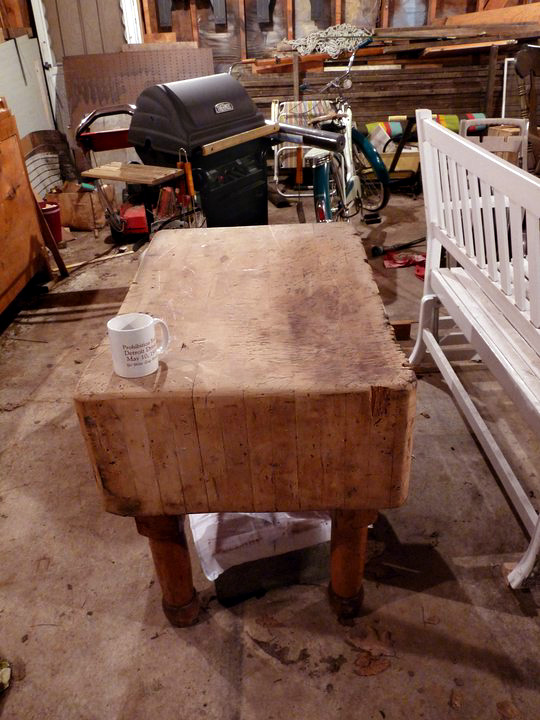
top of this page ("A Butcher Block from Ridgway Refrigerator Co.")
Part I; The Butcher Block's Life
Part II. The Butcher Block and Me
home for this Website (such as it is) UCAN RETURN w/BackButton
Suggestions for changes, fixes: jerry-VA at removethistext speakeasy dot net
Rev 4Nov09; 17Jun2016 text flow/ambiguities; fan mail; 5Feb2018 moved on server for flatter file structure
Rev 25Jun2018 Oh my, how can there still be so many typos? :-(
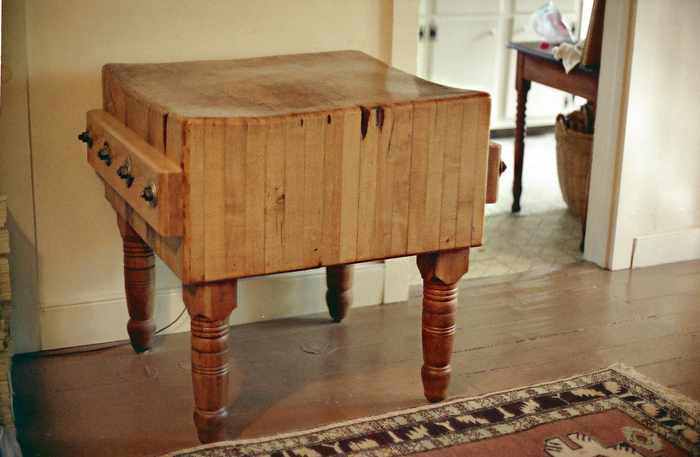

 BOLTS:
The original block had
four 5/8" through-rods, threaded 5/8-11
(NC,
standard National Coarse threading). Adding the knife holders required
new, longer rods (again, 5/8-11). All butcher blocks
this size
that I have seen have through-rods, but on some blocks, nut and washer
are in a recessed hole, and the hole is covered with a wooden
plug. This block originally had cup-shaped metal bolt covers
over
the nuts.
BOLTS:
The original block had
four 5/8" through-rods, threaded 5/8-11
(NC,
standard National Coarse threading). Adding the knife holders required
new, longer rods (again, 5/8-11). All butcher blocks
this size
that I have seen have through-rods, but on some blocks, nut and washer
are in a recessed hole, and the hole is covered with a wooden
plug. This block originally had cup-shaped metal bolt covers
over
the nuts.  Long
7/4 boards (12 feet, not 16 inches) from this era were used to make
maple counter tops. Older counters have boards as wide as 12
inches. Gluing (joining) boards edge-to-edge to reach the desired
counter top width is sometimes called "jointed
flat-grain construction".
The counter top exposes boards of varying widths, some
well-figured -- with a nice "grain" pattern, people say. But
"grain" is the wood's small fibers ("That water raised the grain -- the
board feels fuzzy." "The plane caught, it lifted the grain and made a
small pock mark."). Pretty patterns that tree rings trace across
a board's surface are the wood's "figure."
Long
7/4 boards (12 feet, not 16 inches) from this era were used to make
maple counter tops. Older counters have boards as wide as 12
inches. Gluing (joining) boards edge-to-edge to reach the desired
counter top width is sometimes called "jointed
flat-grain construction".
The counter top exposes boards of varying widths, some
well-figured -- with a nice "grain" pattern, people say. But
"grain" is the wood's small fibers ("That water raised the grain -- the
board feels fuzzy." "The plane caught, it lifted the grain and made a
small pock mark."). Pretty patterns that tree rings trace across
a board's surface are the wood's "figure."  edge
and gluing the plain-sawed faces. For a 2 1/4" thick
industrial
counter top, for example, all the 7/4 maple boards are ripped
and jointed to that 2
1/4" width, then glued. The counter top with this "edge-grain
construction"
exposes homogeneous-width strips with little or
no
figure, but greater surface hardness.
edge
and gluing the plain-sawed faces. For a 2 1/4" thick
industrial
counter top, for example, all the 7/4 maple boards are ripped
and jointed to that 2
1/4" width, then glued. The counter top with this "edge-grain
construction"
exposes homogeneous-width strips with little or
no
figure, but greater surface hardness. 


 Pinchot
was a utilitarian untouched by Muir's respect for the spiritual value
of beauty.. For Pinchot, the world was new, and Man
would
control it. Man controlled nature; and nature would support
man
as he spread and multiplied. For Pinchot, forests were tree
farms
-- cut one down, plant another. If planted trees made softer
wood, that was an engineering problem. If native growth trees
made boards with swirling figures, that only made them harder to mill
into furniture. If swirling figures looked different from
plain
grain, that was only beauty and of no intrinsic value to Man's
Progress. Theodore Roosevelt came to Gifford
Pinchot's wedding. His wife
added
an outside dining room to their mansion so that more guests could be
entertained as the couple sought the Senate, the House and the state
governorship. Buoyant bowls floated the food from guest to guest at
"The Finger Bowl" table (photo, right). The family
mansion is open to
the public today.
Pinchot
was a utilitarian untouched by Muir's respect for the spiritual value
of beauty.. For Pinchot, the world was new, and Man
would
control it. Man controlled nature; and nature would support
man
as he spread and multiplied. For Pinchot, forests were tree
farms
-- cut one down, plant another. If planted trees made softer
wood, that was an engineering problem. If native growth trees
made boards with swirling figures, that only made them harder to mill
into furniture. If swirling figures looked different from
plain
grain, that was only beauty and of no intrinsic value to Man's
Progress. Theodore Roosevelt came to Gifford
Pinchot's wedding. His wife
added
an outside dining room to their mansion so that more guests could be
entertained as the couple sought the Senate, the House and the state
governorship. Buoyant bowls floated the food from guest to guest at
"The Finger Bowl" table (photo, right). The family
mansion is open to
the public today. 
 I
had to have it. I begged. Donna Fischer asked her
parents if it was OK. They said they weren't raising
hogs
anymore, so if you can figure out how to move it, it's yours.
I
had courted Robin with a real sports car, but now I had a VW bug to
prove I was not only married, but sensible. We borrowed tools
and
unbolted the front seat entirely. My new passenger took up
the
entire passenger side of the car. I didn't want to leave
either
the butcher block or the car seat behind, plus I had a wife.
Robin rode home to Long Island in the back of a VW beetle, with the seat on her lap,
begging
to be let out. The VW bug listed badly to the side.
I could
turn right
at any speed, like being back in my sports car again, but on long
interstate ramps to the left I wondered if we'd hear the running board
scraping on the concrete roadway before the whole package just rolled
down the embankment. We stored the butcher block in a
friend's
basement while I finished my Ph.D. on Long Island and did postdocs in
Chicago and then Australia. The Fulbright to Australia spun
out
into 5 years. On trips home, I went down into the
basement, opened the can of linseed oil, and gave the butcher block
another coat to preserve the wood.
I
had to have it. I begged. Donna Fischer asked her
parents if it was OK. They said they weren't raising
hogs
anymore, so if you can figure out how to move it, it's yours.
I
had courted Robin with a real sports car, but now I had a VW bug to
prove I was not only married, but sensible. We borrowed tools
and
unbolted the front seat entirely. My new passenger took up
the
entire passenger side of the car. I didn't want to leave
either
the butcher block or the car seat behind, plus I had a wife.
Robin rode home to Long Island in the back of a VW beetle, with the seat on her lap,
begging
to be let out. The VW bug listed badly to the side.
I could
turn right
at any speed, like being back in my sports car again, but on long
interstate ramps to the left I wondered if we'd hear the running board
scraping on the concrete roadway before the whole package just rolled
down the embankment. We stored the butcher block in a
friend's
basement while I finished my Ph.D. on Long Island and did postdocs in
Chicago and then Australia. The Fulbright to Australia spun
out
into 5 years. On trips home, I went down into the
basement, opened the can of linseed oil, and gave the butcher block
another coat to preserve the wood.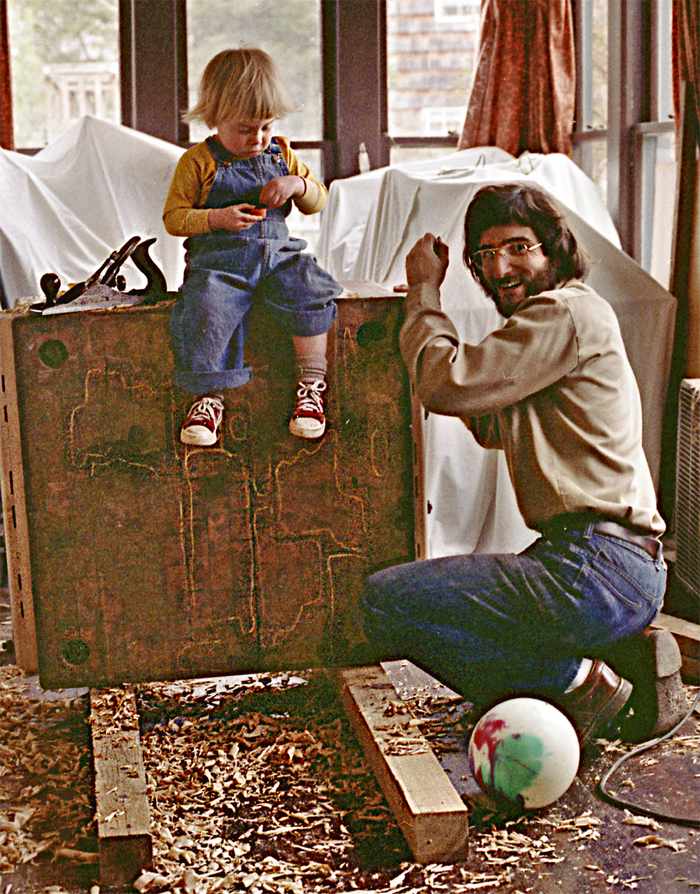

 4. Sand
top, apply finish.
4. Sand
top, apply finish.  GLUING:
I was chicken to glue the block back together. My
excuse
was that I might move, and yes, the whole thing did go to
Germany with
us, but we traveled with His and Hers SeaLand containers and didn't
need to take any furniture apart. The real reason for not
re-gluing was that I
didn't know if I'd ever get the top perfect. I might have to
accept a
corner on an individual piece (or two) that was not lining up because
it had become misaligned during use and that corner got rounded
off. But I got the top perfect. Now that we know all pieces
can slide into
alignment -- I say, Glue it.
GLUING:
I was chicken to glue the block back together. My
excuse
was that I might move, and yes, the whole thing did go to
Germany with
us, but we traveled with His and Hers SeaLand containers and didn't
need to take any furniture apart. The real reason for not
re-gluing was that I
didn't know if I'd ever get the top perfect. I might have to
accept a
corner on an individual piece (or two) that was not lining up because
it had become misaligned during use and that corner got rounded
off. But I got the top perfect. Now that we know all pieces
can slide into
alignment -- I say, Glue it. 
 I
made a support that went under the knife holders, and had my helpers in
Germany put the block up on the supports. I raised the block
3
more inches with two
pairs of wedges to get the legs into their holes, then lowered the
block
to drive the legs in. After adjusting the legs' fox tail
wedges
for a tight fit for each leg (see below), I took the supports away.
I
made a support that went under the knife holders, and had my helpers in
Germany put the block up on the supports. I raised the block
3
more inches with two
pairs of wedges to get the legs into their holes, then lowered the
block
to drive the legs in. After adjusting the legs' fox tail
wedges
for a tight fit for each leg (see below), I took the supports away.

